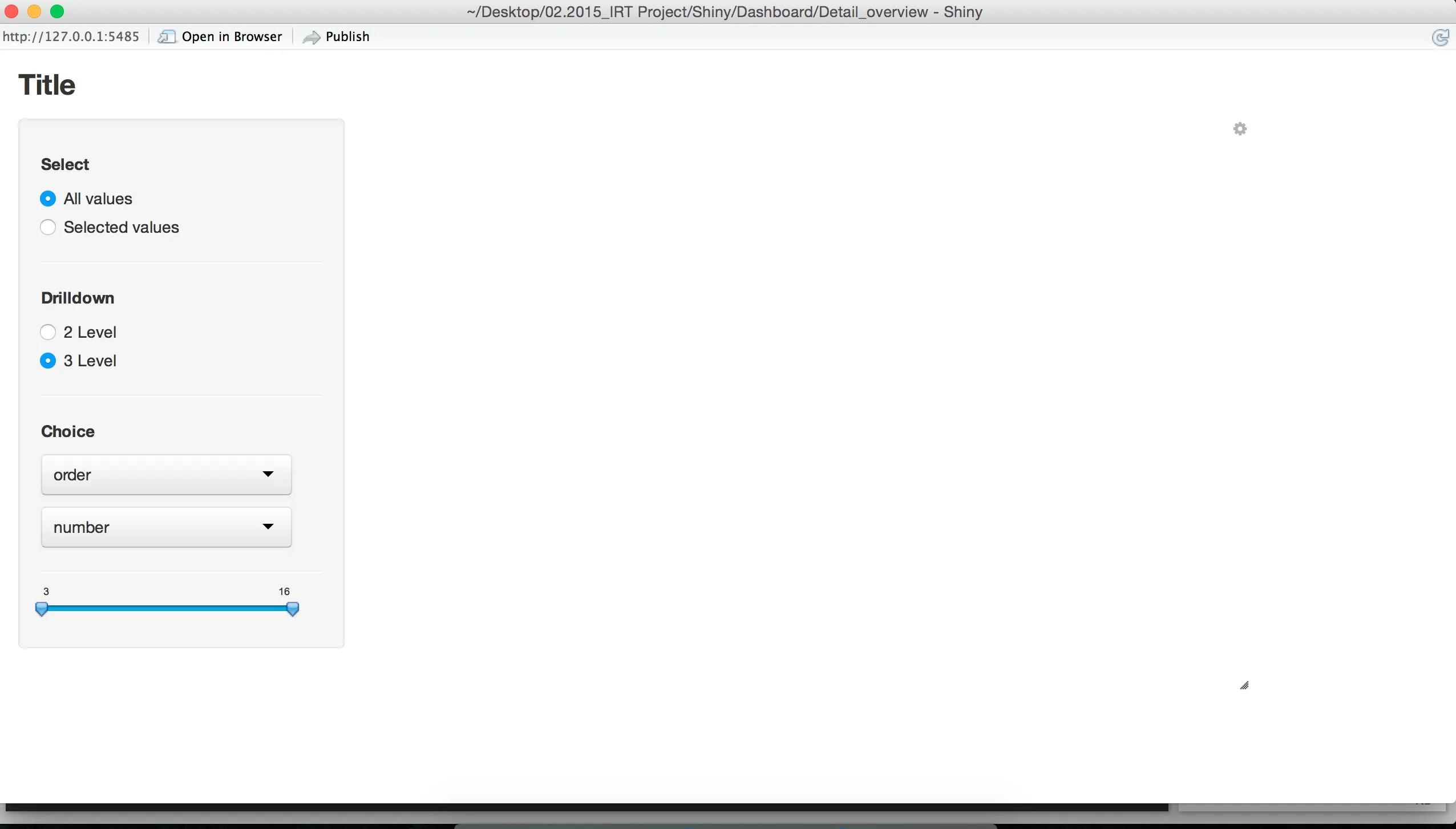我在Shiny中遇到了一个奇怪的问题。我的Shiny应用程序有一个ggvis图,其中包含
layer_points()和几个选项来操作该图。当我运行应用程序时,有时即使我更改所有选项,一切都很好,但有时(我想没有特定的规则)图表会消失。当我更改其中一个选项时,图表会重新出现,但这并不是很好。
我研究了这个问题,但我不知道它是否是我的问题的解决方案。
当图表消失时,我的Shiny应用程序如下所示:

ui.R
library(ggvis)
library(markdown)
library(shiny)
library(dplyr)
library(magrittr)
shinyUI(
fluidPage(
h3("Title"),
fluidRow(
column(3,
wellPanel(
radioButtons("radio",h5("Select"),choices=list("All values","Selected values"),
selected="All values"),
conditionalPanel(
condition = "input.radio != 'All values'",
checkboxGroupInput("checkGroup",label = "",
choices,
selected = c("AT1","AT2"))
),
hr(),
radioButtons("dataset", label = h5("Drilldown"),
choices = list("2 Level" = "df1", "3 Level" = "df2")
),
hr(),
h5("Choice"),
selectInput("xvar", h6(""),
axis_vars_x,
selected = "value"),
selectInput("yvar", h6(""),
axis_vars_y,
selected = "number2"),
hr(),
uiOutput("slider")
)
),
column(9,
ggvisOutput("plot")
)
)
)
)
server.R
library(shiny)
shinyServer(function(input, output,session) {
datasetInput <- reactive({
switch(input$dataset,
df2 = df2,
df1 = df1)
})
axis_vara_y <- reactive({
switch(input$yvar,
number = 2,
number2 = 3)
})
output$slider <- renderUI({
sliderInput("inslider",h5(""), min = round(min(datasetInput()[,axis_vara_y()]),0)-1,
max = round(max(datasetInput()[,axis_vara_y()]),0)+1,
value = c(round(min(datasetInput()[,axis_vara_y()]),0)-1,
round(max(datasetInput()[,axis_vara_y()]),0)+1),
step = 0.5)
})
data <- reactive({
filteredData <- datasetInput()
axisData <- axis_vara_y()
if(!is.null(input$inslider)){
if(input$radio == "All values"){
filteredData <- filteredData %>%
filter(filteredData[,axisData] >= input$inslider[1],
filteredData[,axisData] <= input$inslider[2])
}
else {
filteredData <- filteredData %>%
filter(value %in% input$checkGroup,
filteredData[,axisData] >= input$inslider[1],
filteredData[,axisData] <= input$inslider[2])
}
}
return(filteredData)
})
data_point <- reactive({
data() %>%
mutate(id = row_number())
})
xvar <- reactive(as.symbol(input$xvar))
yvar <- reactive(as.symbol(input$yvar))
dotpoint_vis <- reactive({
xvar_name <- names(axis_vars_x)[axis_vars_x == input$xvar]
yvar_name <- names(axis_vars_y)[axis_vars_y == input$yvar]
data_point_detail <- data_point()
plot <- data_point_detail %>%
ggvis(x = xvar(),y = yvar()) %>%
layer_points(size := 120,fill = ~value) %>%
add_axis("x", title = xvar_name) %>%
add_axis("y", title = yvar_name) %>%
set_options(width = 750, height = 500, renderer = "canvas")
})
dotpoint_vis %>% bind_shiny("plot")
})
global.R
choices <- list("Value1" = "AT1", "Value2" = "AT2",
"Value3" = "AT3", "Value4" = "AT4",
"Value5" = "AT5", "Value6" = "RT1",
"Value7" = "AT6", "Value8" = "AT7",
"Value9" = "AT8", "Value10" = "AT9",
"Value11" = "AT10", "Value12" = "RT2")
levele <- c("AT1","AT2","AT3","AT4","AT5","RT1","AT6","AT7","AT8","AT9","AT10","RT2")
df1 <- data.frame(value = levele,number = seq(2,46,4), number2 = seq(2,24,2),order = 1:12)
df2 <- data.frame(value = levele,number = rep(4:15), number2 = rep(4:9,each = 2),order = 1:12)
df1$value <- factor(df1$value, levels = levele)
df2$value <- factor(df2$value, levels = levele)
axis_vars_y <- c("number","number2")
axis_vars_x <- c("value", "order","number","number2")
更新
我也不知道ggvis中的动画发生了什么。